
Natural history collections
Over three generations, the Macleay family collected insects to form a collection that ultimately expanded into all areas of zoology. Alexander Macleay (1767–1848), his son William Sharp Macleay (1792–1865) and his nephew William John Macleay (1820–1891) were principally responsible for the Macleay natural history collections we value today.
The entomology collection was founded during the heady days of international insect trading of the late 18th century. Alexander Macleay had enviable access to the latest material through his role as Secretary of the Linnean Society of London (1798–1825). With his posting as Colonial Secretary of NSW in 1825, he took with him from England one of largest and the most celebrated collections in Europe. William Sharp Macleay was a distinguished philosophical naturalist, consulted with by Charles Darwin and Thomas Huxley for his ideas on the classification of the natural world. He added to his father's collections, particularly with specimens from South Africa and the Americas. Both collections were inherited by Murrumbidgee squatter and politician, William John Macleay who expanded the collections into all areas of zoology. With his curator George Masters, he avidly collected in Australia and purchased international specimens. Founder of the Linnean Society of NSW, he also led the first Australian overseas scientific expedition (to New Guinea) on the Chevert.
These zoological collections, along with a large collection of cultural material made across Oceania, were donated to the University for for the benefit of teaching and research in 1874.
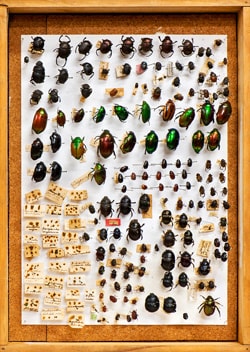 Scarab beetles
Scarab beetles
We curate over 300,000 international insect specimens. Unique in Australia, because of the provenance and age of the specimens as well as their curation, the collection is used for research by entomologists and historians.
Celebrated collection items include the 'whistle cricket', Gryllus spinulosus, collected in 1756 from North Africa, insects from 'New Holland' collected before 1818, lice acquired on HMS Resolution by Johann and George Forster from an albatross on the 24 October, 1772 and a flea taken from an armadillo by Charles Darwin.
These illustrious insects carefully pinned in bespoke furniture cabinets are part of Alexander and William Sharp Macleay's legacy. Today thousands are maintained in their 19th century taxonomic pinnings within the original wood and glass cabinets.
As the collection grew George Masters, and subsequent curators (such as Keith Henry, Elizabeth Hahn, 'Woody' Horning and Elizabeth Jefferys) have slowly re-pinned material to reflect modern taxonomic order. We have recently embarked on assigning a unique number to each animal. Spiders and weevils can now be searched for online.
There are significant numbers of specimens in the orders: Coleoptera, Diptera, Hemiptera, Hymenoptera, and Lepidoptera, with smaller selections in most other orders.
In 1969, over 5000 predominantly Australian types were transferred to the Australian National Insect Collection in Canberra as a "permanent loan". At present, around 580 types remain in the entomology collection, though additional types are often discovered as collection work continues.
Selected associated Literature
- Britton, E.B. & P.J. Stanbury. 1982. Type specimens in the Macleay Museum, University of Sydney. VIII. Insects: beetles (Insecta: Coleoptera). Proceedings of the Linnean Society of New South Wales 105: 241-293.
- Cross D, Jefferys E. 2010. Catalogue of Insects Collected by William Sharp Macleay in Cuba 1825–1836. Proceedings of the Linnean Society of New South Wales. 131:27–35.
- Fletcher, M.J., M.F. Day & M. Humphrey. 2003. The discovery of the holotype of Ledromorpha planirostris (Donovan) (Cicadellidae: Ledrinae), with notes on other Australian Auchenorrhyncha species described by Edward Donovan. General & Applied Entomology 32: 23-30.
- Hahn, D.E., 1962. A List of the Designated Type Specimens in the Macleay Museum. Insecta. Macleay Collections, University of Sydney. 184 pp.
- Naumann, I.D., J.C. Cardale, R.W. Taylor & J. MacDonald. 1994. Type specimens of Australian Hymenoptera (Insecta) transferred from The Macleay Museum, University of Sydney, to the Australian National Insect Collection, Canberra. Proceedings of the Linnean Society of New South Wales 114: 69-72.
- Palma, R.L. 1991. Two bird lice (Insecta:Phthiraptera) collected during Captain Cook’s 2nd voyage around the world. Archives of Natural History 18(2): 237-247.
- Pilgrim, R.L.C. 1992. An historic collection of fleas (Siphonaptera) in the Macleay Museum, Sydney, Australia. Proceedings of the Linnean Society of New South Wales 113: 77-86.
- Stevens, M.M., & M. Carver, 1986. Type-specimens of Hemiptera (Insecta) transferred from the Macleay Museum, University of Sydney, to the Australian National Insect Collection, Canberra. Proceedings of the Linnean Society of New South Wales 108: 263–266.
- Whitley, G.P. & P.J. Stanbury, P.J. 1976. Type specimens in the Macleay Museum, University of Sydney. VII. The holotype of Gryllus spinulosus Johansson. Proceedings of the Linnean Society of New South Wales 100: 202-204.
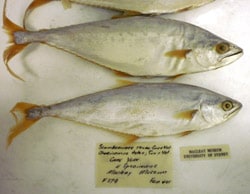 Scomberoides toloo
Scomberoides toloo
The fish collection includes over 2200 lots (individuals or jars of individuals) of alcohol, mounted and skeletal specimens. It formed the foundation of Sir William John Macleay’s catalogue of Australian fishes (1881,1884), as well as Alleyne and Macleay’s (1877) report on specimens from Queensland, the Torres Straits and southern New Guinea collected during the Chevert Expedition, and Macleay’s works on New Guinea fishes collected by Andrew Goldie.
Peter Stanbury (1969) published a list of type specimens known at that time, these were subsequently transferred to the Australian Museum on "permanent loan" and allocated additional Australian Museum registration numbers. Ongoing research has led to the rediscovery of lost Sir William fish types in the Macleay Museum, as well as those of some species described by his colleagues, including Count F. de Castelnau and J.D. Ogilby.
References
- Alleyne, H.G. & W. Macleay. 1877. The ichthyology of the Chevert expedition. Proceedings of the Linnean Society of New South Wales 1: 261-281, 321-359, pls. 3-17.
- Macleay, W. 1881. Descriptive catalogue of the fishes of Australia. Parts I-IV. Proceedings of the Linnean Society of New South Wales 5: 302-444, 510-629, pls. 13-14; 6: 1-138, 202-387. <Part I> <Part II> <Part III> <Part IV>
- Macleay, W. 1884. Supplement to the descriptive catalogue of the fishes of Australia. Proceedings of the Linnean Society of New South Wales 9: 2-64.
- Stanbury, P.J. 1969. Type specimens in the Macleay Museum, University of Sydney. I. Fishes. Proceedings of the Linnean Society of New South Wales 93: 203-210.
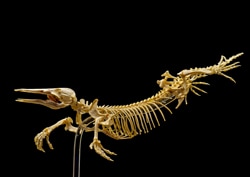 Ornithorhynchus anatinus [platypus skeleton]
Ornithorhynchus anatinus [platypus skeleton]
Marsupials from Australia and New Guinea dominate the mammal collection, with the majority collected before 1885.
Seeking to make the collection purposeful for University teaching, William John Macleay also made extensive purchases of mammals from USA-based dealers and through chance acquisitions from visiting collectors.
There are three kinds of preparations of the mammals: research skins, taxidermy mounts and skeletal (parts and wholes). A smaller number are stored in water-ethanol solutions.
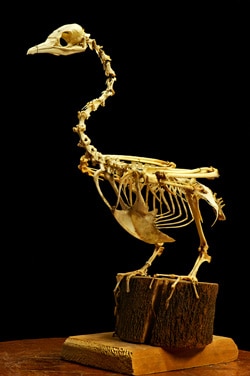 Cormorant skeleton
Cormorant skeleton
There are 8000 bird skins, taxidermy mounts and skeletons, 1200 eggs and 100 nests in this collection.
The majority were acquired during WJ Macleay's lifetime from collection expeditions (particularly the Chevert), purchases from dealers and acquisitions via his networks of exchange.
The following regions' bird populations are well-represented: West Africa, Northern, Central and South America, Aotearoa – New Zealand, Australia, India, Indonesian archipelago and New Guinea. Smaller numbers of specimens document bird species from Europe, Asia and the Pacific.
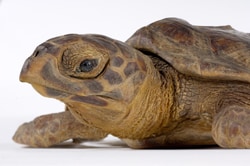 Eretmochelys imbricata, photograph: Michael Myers
Eretmochelys imbricata, photograph: Michael Myers
The herpetological collections consist of amphibians, snakes, lizards, turtles, and crocodiles collected between 1870 and 1940. The majority of these collections are preserved in ethanol.
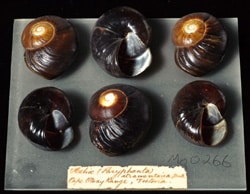 Helix (parayphanta) atramentaria, photograph: Michael Myers
Helix (parayphanta) atramentaria, photograph: Michael Myers
Conchology (shells) was the principal interest in this animal group in the 19th century. Because of this, few of the animals living within the shell are preserved in the collection.
WJ Macleay's fellow Sydney-based collectors, John Brazier and James Cox, swapped, traded and sold parts of their collections internationally. Some of the Macleay material came from these conchologists, but are yet to be identified.
There are 9000 lots (individuals or groups of individuals); of which around 3000 represent land-based animals (land-snails).
For fossil shells see the fossil collection.
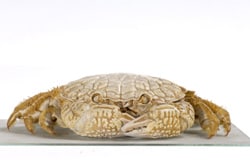 Zosimus aeneus [poisonous crab]
Zosimus aeneus [poisonous crab]
The Macleay Collections hold over 3500 crustacean specimens, largely collected between 1800 and 1900, from Australia, Africa, Europe, North America, South America, Pacific Ocean, Indian Ocean, and the Carribean.
Selected associated literature
- Ahyong ST, Norrington SF. 1997. Stomatopod Crustacea of the Macleay Museum, University of Sydney. Proceedings of the Linnean Society of New South Wales. 118:98–110
Over 1000 fossils are held in the collection largely through three distinct acquisitions:
- plant fossils collected by Julian Tennison-Woods (1832-1889)
- Eocene molluscs from Tuscany and the Paris Basin, probably acquired by WS Macleay
- bird fossils, including many parts of Pachyornis (moa) species some of which came from Canterbury Museum curator, Johann von Haast (1822-1887).
 Pseudopterogorgia sp with ophiuroids
Pseudopterogorgia sp with ophiuroids
The Macleay Collections maintain collections of late 19th-century marine invertebrates; including sponges, echinoderms, and polychaete worms.
A small number of sponge type specimens are held, relating to the work of NN Miklouho-Maclay and Robert von Lendenfeld.
